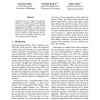ACL
2007
14 years 1 months ago
2007
We present a novel method for predicting inflected word forms for generating morphologically rich languages in machine translation. We utilize a rich set of syntactic and morphol...
ACL
2007
14 years 1 months ago
2007
We present an implemented system for the resolution of it, this, and that in transcribed multi-party dialog. The system handles NP-anaphoric as well as discoursedeictic anaphors, ...
ACL
2008
14 years 1 months ago
2008
We extend the classical single-task active learning (AL) approach. In the multi-task active learning (MTAL) paradigm, we select examples for several annotation tasks rather than f...
ACL
2007
14 years 1 months ago
2007
Identification of transliterated names is a particularly difficult task of Named Entity Recognition (NER), especially in the Chinese context. Of all possible variations of trans...
ACL
2008
14 years 1 months ago
2008
Parse-tree paths are commonly used to incorporate information from syntactic parses into NLP systems. These systems typically treat the paths as atomic (or nearly atomic) features...
ACL
2008
14 years 1 months ago
2008
We propose the use of regular tree grammars (RTGs) as a formalism for the underspecified processing of scope ambiguities. By applying standard results on RTGs, we obtain a novel a...
ACL
2007
14 years 1 months ago
2007
We present a novel framework that combines strengths from surface syntactic parsing and deep syntactic parsing to increase deep parsing accuracy, specifically by combining depend...
ACL
2008
14 years 1 months ago
2008
In adding syntax to statistical MT, there is a tradeoff between taking advantage of linguistic analysis, versus allowing the model to exploit linguistically unmotivated mappings l...
ACL
2007
14 years 1 months ago
2007
We describe an open-source toolkit for statistical machine translation whose novel contributions are (a) support for linguistically motivated factors, (b) confusion network decodi...
ACL
2008
14 years 1 months ago
2008
We propose an automatic machine translation (MT) evaluation metric that calculates a similarity score (based on precision and recall) of a pair of sentences. Unlike most metrics, ...

